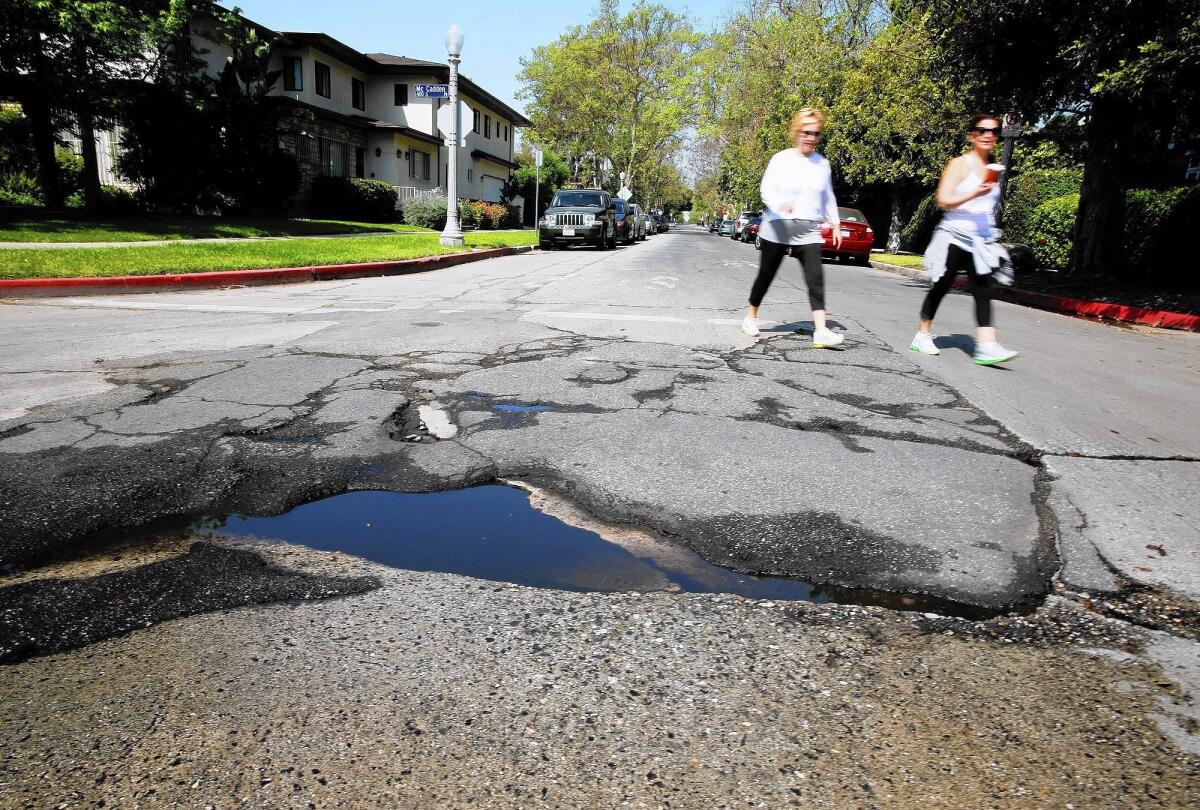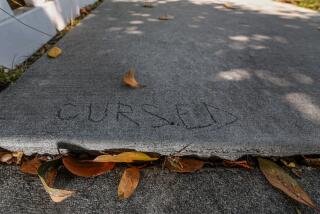Shoddy U.S. roads and bridges take a toll on the economy

Reporting from PROVIDENCE, R.I. — It was a beautiful May afternoon when Donnel Gomes took his week-old silver Mercedes for a spin into the city. He turned onto Broad Street, a main thoroughfare downtown, and … kaboom!
The car fell into a huge pothole, blowing its right tire, ripping the front axle and knocking out the air-bag system. Cost: $3,800.
“It was a wreck,” said the 48-year-old electrician, although he reckoned he got off easy compared with a motorcyclist whom Gomes saw thrown into the air after hitting a crater on another downtown street. “A damn minefield,” he said of traversing many of Providence’s roads.
Rhode Island has an unusually large share of shoddy highways, streets and bridges, but it’s not much better in the rest of the country.
America’s transportation infrastructure, once an engine of mobility and productivity, has fallen into such disrepair that it’s become an economic albatross.
Consumers shell out billions of dollars for extra car repairs every year. Insufficient and poorly maintained roads mean costly bottlenecks for businesses, which discourage expansion and hobble American companies competing in the global economy.
Congestion on major urban highways costs the economy more than $100 billion a year in fuel and lost work time, estimates the American Society of Civil Engineers.
And, says said Casey Dinges, the engineering group’s senior managing director: “It’s become a white-knuckle experience for many commuters.”
Age is a key factor. Most of the major highways were built decades ago.
America’s transportation structures look all the more frayed next to those in advanced economies in Europe and Japan, or in China, which has been busily constructing high-speed rail and new airports.
U.S. spending for transportation and other infrastructure accounts for 2.4% of its economy versus about 12% for China, says economist David Dollar, a former China director for the World Bank. Europe’s infrastructure spending is about 5%.
Dollar, now with the Brookings Institution, says visiting Chinese officials and business leaders frequently remark how surprised they are at America’s declining infrastructure, sometimes asking whether they can help finance improvements.
American politicians, from President Obama down to small-town mayors, decry the deplorable condition of infrastructure, but many are reluctant to raise taxes or boost tolls and user fees.
Between the federal government and local entities, government spending for highways runs less than $90 billion a year, which is barely enough to maintain the status quo, let alone improve roadway conditions and performance.
That’s partly why the share of congested highways in U.S. cities has risen from 25% in the early 1980s to more than 40% today, according to the Transportation Department. Roads with “acceptable ride quality” fell from 87% in 1995 to 82% in 2010.
It’s especially tough for states such as Rhode Island that have been lagging economically and depend heavily on Uncle Sam for transportation funds. The federal highway program is funded by an 18.4-cents-per-gallon gas tax, but that hasn’t budged since 1993.
Now, the fund is on the verge of insolvency. Congress came through last week with a last-minute replenishment of money, but it’ll only last until May.
The upshot is that states and localities make do with what they can.
A quarter of the country’s 147,870 bridges are deficient or obsolete, according to a July report by the White House on infrastructure investment. Rhode Island’s are in the worst shape in the nation, with 57% of its bridges falling into those categories.
One of them, Middle Road Bridge in East Greenwich, south of Providence, runs over a key freeway and leads to the town’s high school. Buses filled with students have been rumbling over the 235-foot bridge for years. When Dan Paolino and his crew began maintenance work on it this summer, he found that some of the supporting beams underneath were so beaten down by time and rainwater that they were “paper-thin.”
“Yeah, pretty scary,” says Paolino, a superintendent at Cardi Corp. construction, as he bends below a beam and scrapes off a layer of rusted steel with his bare fingers.
New Englanders and those in tough-climate cities like Chicago are used to swerving around potholes, depressions and other unsightly road hazards caused by nature’s freezing-and-thawing cycle and man’s salting of the streets.
Largely because of the brutal winter, New Jersey got nearly 10,000 reports of potholes in the year that ended June 30, more than double the previous 12 months. Rhode Island has already paid drivers nearly triple the amount for pothole damages last winter and spring as it did a year earlier — and the state is still processing claims.
Some of the worst roads, however, are in sunny California. All told, about a third of the state’s public roads are in bad shape, compared with 14% nationally.
TRIP, a transportation research group, says that works out to an extra $832 in maintenance costs for the typical motorist in Los Angeles, more than double the national average of $377.
Daniel Sperling, director of the Institute of Transportation Studies at UC Davis, says California’s road problem is largely twofold: heavy use and deferred maintenance. “The amount of vehicles and usage have gone up, but the amount of revenue has been frozen or [is] decreasing.”
Some localities, including Los Angeles, have resorted to an increase in sales tax to pay for transportation needs. But that’s nowhere near enough, Sperling says, adding that with greater fuel efficiency requirements on cars, funding from gasoline taxes is likely to get even tighter.
Leonard Lardaro, an economics professor at the University of Rhode Island who has been tracking Rhode Island’s economy for two decades, says decaying infrastructure is a burden on the state.
Once a hub of textile production and the nation’s center for costume jewelry production, Rhode Island has shifted largely to a service economy, as has the rest of the country. Its prosperity is tied to healthcare, tourism and business services.
But the state has persistently lagged behind others in the recovery, with higher unemployment and slower job growth. Lardaro says that’s no coincidence.
Infrastructure improvements, he says, “are investment-oriented activities. They generate future growth.”
More to Read
Sign up for Essential California
The most important California stories and recommendations in your inbox every morning.
You may occasionally receive promotional content from the Los Angeles Times.











